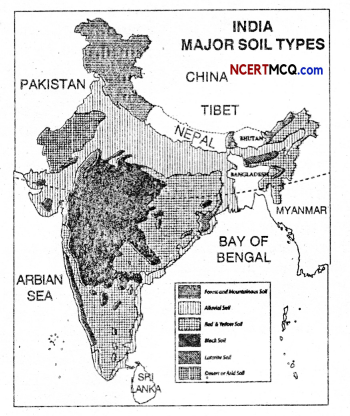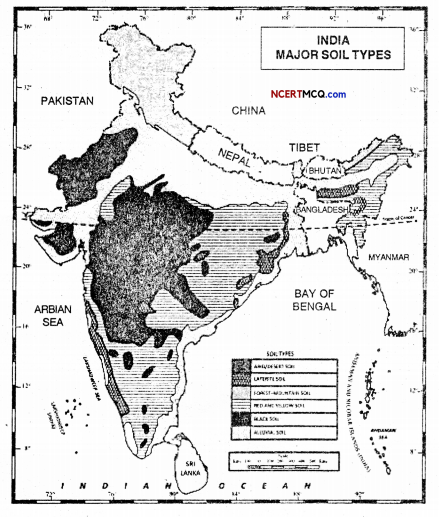Check the below Online Education for NCERT MCQ Questions Class 10 Geography Chapter 1 Extra Questions and Answers Resource and Development Pdf free download. https://ncertmcq.com/extra-questions-for-class-10-social-science/
Online Education for Resource and Development Class 10 Extra Questions Geography Chapter 1
Class 10 Geography Chapter 1 One Mark Questions Question 1.
What do you mean by soil?
Answer:
The uppermost layer of the earth’s crust, which is loose, fragmented and useful for plants, is known as soil.
Class 10 Geography Chapter 1 Extra Questions Question 2.
Point out the factors which contribute to the formation of soil.
Answer:
The main factors which contribute in the formation of soil are the following-
- Rocks
- Climate
- Plants
- Animals
- Local Topography
- Long period of time.
Class 10 Geography Chapter 1 Very Short Questions And Answers Question 3.
In which tyes the soils were classified in ancient India?
Answer:
In the ancient India, soils were classified on the fertility basis-
- Fertile (Urvara)
- Sterile (Utara).
Class 10 Geography Chapter 1 Extra Questions And Answers Question 4.
How are soil classified on the basis of texture?
Answer:
Soils are classified into the following types or the basis of their texture
- Sandy
- Clayey
- Loamy.
Geography Class 10 Chapter 1 Extra Questions Question 5.
What do you mean by Khadar?
Answer:
Khadar is meant by new alluvial soil which is sandy and light in colour and is found close to rivers.
Class 10 Geography Chapter 1 Extra Questions Pdf Question 6.
What is Bhangar?
Answer:
Bhangar is the old alluvial soil which is clayey and dark. It is found away from rivers.
![]()
Class 10 Geography Chapter 1 Extra Questions Pdf Download Question 7.
Write down the other name of black soil.
Answer:
Regur.
Extra Questions Of Resources And Development Class 10 Question 8.
What is meant by Ravines?
Answer:
Ravines are the badlands in the Chambal basin.
Class 10 Geography Chapter 1 Important Questions Question 9.
What gives red colour to the red soil?
Answer:
The red soil gets its colour from the presence of iron.
Class 10 Geography Chapter 1 Extra Question Answer Question 10.
To which state is black soil predominantly confined?
Answer:
Black soils are confined to certain parts of Maharashtra, Madhya Pradesh, Gujarat and Tamil Nadu.
Class 10 Geo Ch 1 Extra Questions Question 11.
How can land degradation in industrial and suburban areas can be reduced?
Answer:
Land degradation in industrial and suburban areas may be reduced by proper discharge and disposal of industrial effluents and wastes after treatment.
Ncert Class 10 Geography Chapter 1 Extra Questions Question 12.
Why is soil considered a prime resource?
Answer:
Soil is considered a prime resource because it supports life on the earth. All of the living organisms like plants, animals as well as humans are dependent on soil for their food.
Extra Questions For Class 10 Geography Chapter 1 Question 13.
Though India has a very little pasture land yet it has the highest number of cattle. Do you agree?
Answer:
India had only 4% of its land under pastures. Yet it manages the largest number of the cattle. The main reason for this is that the cattle in India are reared mainly on husk, gain chaff and farm waste and a few fodder crops. This is the most economical way to have a large number of drought animals.
Geography Chapter 1 Class 10 Extra Questions Question 14.
Point out the important factors determining the utilisation of land.
Answer:
There are two sets of factors that determine the use of land in India :
- Physical factors including topography, climate, and nature of the soil,
- Human factors mainly density of population and the level of economic exploitation of natural resources.
Extra Questions Of Geography Class 10 Chapter 1 Question 15.
Point out the main causes of increase in wasteland.
Answer:
Wasteland is that land which is agriculturally unproductive. The land which is either sandy, rocky or arid is a wasteland. Some lands become wasteland because of human negligence.
![]()
Cbse Class 10 Geography Chapter 1 Extra Questions Question 16.
Suggest appropriate steps for resource planning.
Answer:
Resources are very valuable forces. If we do not plan them properly we wouldn’t have them anymore in future. Hence the development in future would stop. Because of this fact we must plan our resources very wisely. The following steps may be taken for achieving this goal-
- Wet and marshy lands should be reclaimed and in the same time available lands should be put to optimum use.
- Rivers should be linked to each other and in desired direction.
- The changing of the directions of the river would prevent the water going waste into the sea.
- The wastewater from the factories should be recycled to be used over and over again.
- More special attention should be given to the non-renewable resources like minerals etc.
- For the above purpose wastage during mining and processing should be reduced to the minimum.
- Whenever and wherever possible, alternative products like wood and plastic should be used.
- To prolong the life of our limited metallic mineral resources, scrap should be recycled. Processing iron scrap into steel is a good example.
- New methods should be devised for utilising ores of lower grade.
- To make ourselves sure that the coming generations are not deprived of the benefits of the minerals resources, we should use the available stock of mineral wealth most judiciously.
If we take above steps wisely, we would be able to plan and save our resources in the wisest way.
Class 10 Geography Chapter 1 One Mark Questions Pdf Question 17.
Briefly introduce the soils found in India.
Or
Which are the main types of soils that are found in India?
Answer:
India is very rich in matter of soils. Indian soils have been classified in various ways. In ancient India, soils were classified on the basis of the fertility as urvara and usara. In the present time soils are classified on the basis of colour.
A brief introduction of the Indian soils may be presented in the following words-
1. Alluvial soil-This type of soils is found over large parts of the country. These are confined mainly to the northern plains, coastal strips and Chhattisgrah basin. This type of soil is generally of two types-
- Khadar-the newer alluvium.
- Bhangar-the older alluvium.
The Khadar is sandy and light in colour. On the other hand the Bhangar is clayey and dark,
2. Black soils-This is also known as Regur soils. These are known for their cultivation value of cotton. These soils have been derived from the Deccan traps and these occur mainly in Maharashtra, Western Madhya Pradesh and Gujarat. In these areas, the black soils are generally deep. Black soils are also found in parts of Karnataka, Andhra Pradesh and Tamil Nadu.
3. Red soils-These are formed in the areas of igneous and metamorphic rocks. These have in fact developed as the result of weathering. Its red colour is due to the presence of iron in it. These are highly porous and fertile when they are fine-grained and deep. Red soil mainly occur in parts of Tamil Nadu, Karnataka, Andhra Pradesh, Orissa and Jharkhand.
4. Laterite soil-These are intensively leached soils of the monsoon climate. They lack in elements of fertility and they are normally of low value of crop production. They are red in colour and composed of little clay and much gravel of red sandstones. These soils are well developed in hills of the Deccan, Karnataka, Kerala, Orissa and even in the parts of Assam and Meghalaya.
5. Mountain Soils-These soils are found in mountainous regions of the country, particularly in Meghalaya, Arunachal Pradesh, eastern ranges, Uttaranchal, Himachal Pradesh and Jammu and Kashmir.
This type of soils is characterised mainly by deposition of organic materials derived from vegetative cover. These soils are heterogeneous in nature and vary from place to place. For example in the Shiwalik hills, the soils are shallow and immature containing large proportion of decomposed mineral grains. These are also sandy with gravel, porous and devoid of humus.
6. Desert soils-These soils are found in the arid and the semiarid conditions. These are mainly found in the arid areas of Rajasthan, Punjab and Haryana. The sands are partly of local origin and partly have been blown in from the Indus valley. In some areas, the soils also contain high percentage of soluble salt lack in organic matter. Scarcity of water is the main limiting factor for agriculture.
![]()
Multiple Choice Questions
Question 1.
India has the following percentage of plateau land.
(a) 27%
(b) 43%
(c) 30%
(d) 25%
Answer:
(d) 25%
Question 2.
The plateau land area does not have the following.
(a) minerals
(b) forests
(c) perennial rivers
(d) fossil fuels.
Answer:
(c) perennial rivers
Question 3.
Black soil is found in one of the following states of India.
(a) Punjab
(b) Maharashtra
(c) Haryana
(d) Himachal Pradesh.
Answer:
(b) Maharashtra.
![]()
Question 4.
Yellow and red soils are found in.
(a) Chhattisgarh and Orissa
(b) Orissa and Punjab
(c) Punjab and Chattisgarh
(d) Chattisgarh and Haryana
Answer:
(a) Chhattisgarh and Orissa.
Question 5.
Gully erosion is quite pronounced in the following state.
(a) Uttar Pradesh and Madhya Pradesh
(b) Madhya Pradesh and Punjab
(c) Punjab and Rajasthan
(d) Rajasthan and Jammu-Kashmir.
Answer:
(a) Uttar Pradesh and Madhya Pradesh
Map Skills
Question 1.
On an outline map of India, show the distribution of soils.
Answer:

Question 2.
On an outline map of India show the following:
(i) Areas of black soil
(ii) Chambal ravines
(iii) Thar desert,
Answer:

